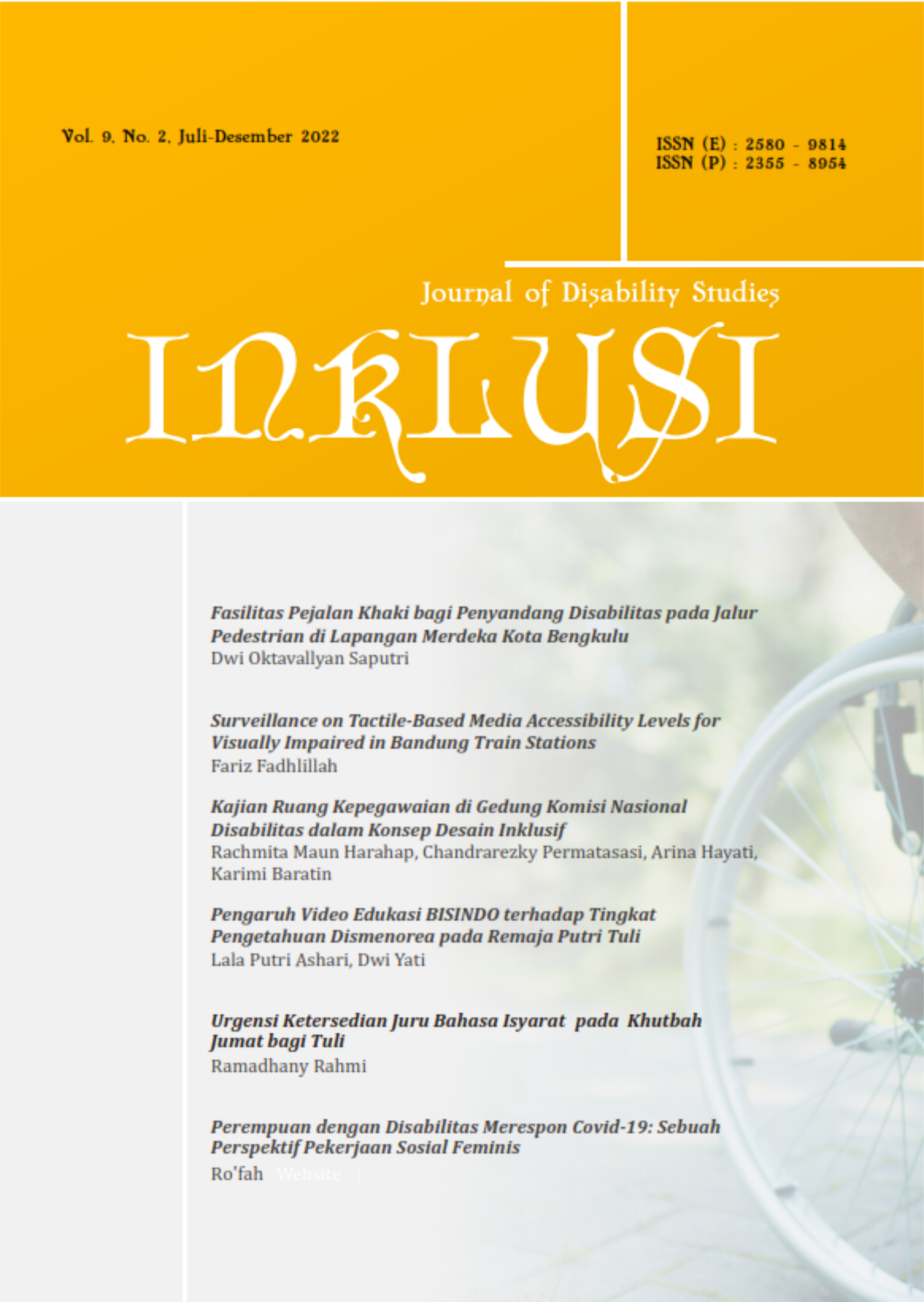Kajian Ruang Kepegawaian Di Gedung Komisi Nasional Disabilitas dalam Konsep Desain Inklusif
Main Article Content
Abstract
The purpose of the study is to identify the design aspects of working environment based on the experience of people with disability. The first floor of Komisi Nasional Disabilitas (KND) workspace which used by National Commission for Disabilities as its secretariat, will be the priority case of this study. The study examine how to implement the inclusive design concept in the workplace focus on realizing equal opportunities in the implementation of Respect, Protection and Fulfillment of the Rights of Persons with Disabilities. The research use qualitative approach, include the use of methods such as in-depth interviews, participant observation, architectural and interior elements’ measurement based on Universal Design and Deaf Space principles. Quantitative approach is also applied by using questioners’ assessment for measuring values of environment by way of comparison with the regulations of Universal Design and Deaf Space guidelines. The results shows that personal experience of people with disability plays important role to evaluate their environment. The meaning of inclusive and accessible environment can be vary based on the participants’ interpretation. Yet during the participant observation, the study reveals that the building and interior spaces of KND have not been designed to meet the principles of universal design and deaf space. The participants mostly have done some physical adjustment and spatial/furniture arrangements to meet their personal conditions, needs, and preference to carry out their daily activities independently. In conclusion, this research proposes design parameters from the perspective of the participants elaborated with the principles Universal design and Deaf Space in effort to increase inclusivity for all users.
Downloads
Article Details

This work is licensed under a Creative Commons Attribution-NonCommercial-NoDerivatives 4.0 International License.
* Author(s) are the copyrigth holder(s) of their published articles and to retain publishing rights without restrictions.
References
Bauman, H. (2005). DeafSpace—Campus Design and Planning [Universitas]. Gallaudet University. https://gallaudet.edu/campus-design-facilities/campus-design-and-planning/deafspace/
Bonaccio, S., Connelly, C. E., Gellatly, I. R., Jetha, A., & Martin Ginis, K. A. (2020). The Participation of People with Disabilities in the Workplace Across the Employment Cycle: Employer Concerns and Research Evidence. Journal of Business and Psychology, 35(2), 135–158. https://doi.org/10.1007/s10869-018-9602-5
Cresswell, J. W., & Fawaid, A. (2017). Research Design Pendekatan Kualitatif Kuantitatif, dan Campuran. Pustaka Pelajar.
Doudin, B. (2010). Deaf architecture: Hearing Loss, Space, Lighting and Sign Language. [Pendidikan]. Scribd. https://www.scribd.com/presentation/39436945/DEAF-Architecture
Erissa, D., & Widinarsih, D. (2022). Akses Penyandang Disabilitas terhadap Pekerjaan: Kajian Literatur. Jurnal Pembangunan Manusia, 3(1), 1–18. https://doi.org/10.7454/jpm.v3i1.1027
Goldsmith, S. (2000). Universal Design: A Manual of Practical Guidance for Architects. Architectural Press. http://archive.org/details/UNIVERSAL_DESIGN
Harahap, R. M., & Lelo, L. (2020). Pengalaman Mahasiswa Tuli di Ruang Komunal Universitas Mercu Buana. INKLUSI, 7(2), Art. 2. https://doi.org/10.14421/ijds.070201
Harahap, R. M., Santoso, I., Wahjudi, D., & Martokusumo, W. (2020). Study of Interiority Application in Deaf Space Based Lecture Space: Case study: The Center of Art, Design & Language in ITB Building. Journal of Accessibility and Design for All, 10(2), Art. 2. https://doi.org/10.17411/jacces.v10i2.245
Istifarroh, I., & Nugroho, W. C. (2019). Perlindungan Hak Disabilitas Mendapatkan Pekerjaan di Perusahaan Swasta dan Perusahaan Milik Negara. Mimbar Keadilan, 12(1), 21–34. https://doi.org/10.30996/mk.v12i1.2164
Mace, R. L., Hardie, G. J., Place, J. P., North Carolina State University, & Center for Universal Design. (1991). Accessible Environments: Toward Universal Design. Center for Universal Design, North Carolina State University.
Mujimin, W. M. (2012). Penyediaan Fasilitas Publik Yang Manusiawi Bagi Aksesibilitas Difabel. Dinamika Pendidikan, 14(1). https://eprints.uny.ac.id/5026/
Pramashela, F. S., & Rachim, H. A. (2021). Aksesibilitas Pelayanan Publik bagi Penyandang Disabilitas di Indonesia. Jurnal Pekerjaan Sosial, 4(2), 225–232.
Steinfeld, E., & Maisel, J. (2012). Universal Design: Creating Inclusive Environments (1st edition). Wiley.
Story, M. F., Mueller, J. L., & Mace, R. L. (1998). The Universal Design File: Designing for People of All Ages and Abilities. Revised Edition. Center for Universal Design, NC State University. https://eric.ed.gov/?id=ED460554
Worrel, R. A. (2011). Architectural Communication Accessibility for the Deaf and Hard-of-Hearing in Office Buildings. The Catholic University of America.

